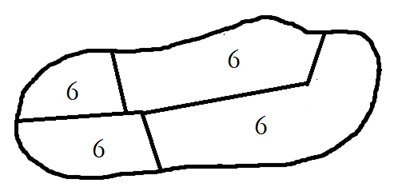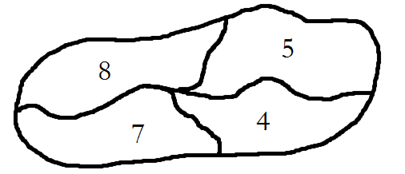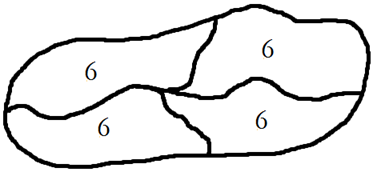This Text Can Be Found in the Book,
The Evolution of Consent: Collected Essays (Vol. I)
Introduction
In this essay, I intend on demonstrating the complementarity between the cost-principle (as used by mutualists), rent-sharing (as displayed by the Georgists), and the principle of non-aggression (as used by the voluntaryists). I will also demonstrate why geo-mutualism is a better way to distribute land than by balancing its use either by individualizing or collectivizing it, as done in the extremes of capitalism and communism. I hope this essay to demonstrate the efficiency, both ethical and practical, of geo-mutualism, and its relatability to the non-aggression and cost-principles.
The Cost-principle
In “The Mutualist Cost-principle,” I outline the dynamic of mutualist economics, which follows the maxim, “cost-the-limit-of-price.” According to this view, any price above or below the cost of manufacture is discouraged, including all forms of taxes, interest, profit, and rent. Wages, salaries, and other labor-based incomes, however, are celebrated.
To the mutualist, cost is not only a matter of political-economy, a measure of proper prices, but is also an ethical concern. To impose costs on another person, without their willing agreement according to mutual exchange, is to act violently, extortively, toward them. After all, mutualists define costs as anything disagreeable to one’s body or rightly-earned property, and, therefore, see the inflicting of costs upon another person as agreeable only under the condition of voluntary exchange, where costs are being traded for mutual benefit (like in a sale).
Within the context of voluntary exchange, one takes a cost upon oneself for another’s sake in order to reduce their own overall costs. The reason for this is best understood through principles such as comparative advantage and economies of scale, whereby division of labor and team-efforts can reduce costs in general. Let’s look at it this way, using comparative advantage:
Say two friends are cooperating in the cooking of a meal; we’ll call these friends Emma and Alexander. Say Emma has had nothing but bad experiences in her time in the kitchen cutting vegetables (say she cut the tip of her thumb off), but she loves to bake. Alexander, let’s say, likes to bake as well, but is a superb food handler, and doesn’t mind doing the job at all. Who should do what job and why?
It should be quite clear that Alexander should be doing the vegetable slicing, and Emma should be making the pie crust; together they will make a delicious pot-pie. Why should each do their specified tasks? Because they are the tasks each hate the least, and which they are best at.
Let’s look at it economically: By taking the job of making the crust, Emma reduces Alexander’s opportunity costs, and frees him to cut more vegetables, the thing he is best at. By cutting the vegetables, Alexander does not only reduce Emma’s opportunity costs, by freeing her to bake more crusts, but he also reduces her direct costs, because Emma hates cutting vegetables (Alexander, we’ll say, is neutral). So, what happens when Emma bakes the crusts and Alexander cuts the vegetables? Costs are reduced for both parties. They are directly reduced for Emma, because she hates cutting vegetables, but there is also a reduction in opportunity costs for both parties, and, due to this comparative advantage, if they specialize according to their preferences and rates of productivity, more can be made.
How their product is divided should reflect the values of each party, and will tend toward a balance of costs, direct and opportunity-based. They can exchange their products loosely by way of exchange, with one of them keeping the final result; they can cooperate in association to produce the pie, and then receive their own portion of the whole to market themselves as independent agents; or they can cooperate in the marketing process as well, and split the final rewards. Their level of association, and method of splitting the income—whether it be by exchange or by dividend— will be determined by their willingness to cooperate, and the value, or lack thereof, for one another’s abilities.
When individuals are left to make their own decisions they are most likely to make decisions they believe will be beneficial (either in the long- or the short-term). The economic position of the completely rational agent, however, must be better defined; behavioral economists have levied many fair shots at this model of economic life. While their understanding of neither the cause, nor solution of the issue, is without flaw, their approach and analysis of the issue, as it stands, is quite valid. Where they fall short, and their view becomes unsound, is when missing the distortion in the market which is caused by money carrying a price (interest).[1]
While behavioral economists certainly understand the positive effects of socialization in regard to the distribution of information, their answer of compulsive association to the state falls short of a real solution, by creating all-new problems related to compulsive authority and forced combinations. Socialization, being around people, can certainly allow one access to more information, and, thus, the ability to make better decisions, but, when one is forced into a political unit, costs are driven up, because decisions begin to be taken from the realm of individual choice and placed in the hands of the political body, which is interested in the well-being of the collective or its mandate, and, many times, at the expense of the individual. While socialization can reduce costs for the individual, this remains so especially in regard to voluntary associations, where one is not coerced into membership, but subscribes freely because it reduces their costs.
Behavioralists are oftentimes guilty of restricting themselves to studying the effects of the current money supply, and thereby ignoring the market for community that already exists with an unmet demand, easily fulfilled by a proper system of currency. As of now, this demand is virtually unmet, or is at least greatly discouraged, because the credit supply has distorted the natural solidarity of interests, and made humanity so inequal as to have differing class relations, leaving most without surplus, and others in continual competition to control the surplus, or anything at all for that matter. Proudhon clarifies our economic condition when he famously illustrates,
The purchaser draws boundaries, fences himself in, and says, “This is mine; each one by himself, each one for himself.” Here, then, is a piece of land upon which, henceforth, no one has right to step, save the proprietor and his friends; which can benefit nobody, save the proprietor and his servants. Let these multiply, and soon the people […] will have nowhere to rest, no place of shelter, no ground to till. They will die of hunger at the proprietor’s door, on the edge of that property which was their birth-right; and the proprietor, watching them die, will exclaim, “So perish idlers and vagrants.”[i]
The class division we suffer occurs within the framework of a particular monetary system that the few find beneficial at the expense of the many, allowing some to become landlords, capitalists, and creditors, while others must remain tenants, workers, and debtors for the rest of their lives. With so many elements of class division already in place, fraternity finds fruition hard indeed. Where it does exist, it exists for those who share class interests, and, because some classes have more leisure and resources than others, this usually entails organizations of the rich working on their own behalf, while workers remain largely divided, socializing only informally and, thus, in economic docility. There are, of course, exceptions to this rule.
Unions, credit unions, mutual insurance programs, cooperatives, building societies, community land trusts, working-class churches, and more, stand as examples of lower and middle class democracy. These groups all exist within the context of the supply and demand for such organizations. When one joins such groups, however, and pays their dues or voluntary tithe, one buys into a particular culture, which eventually informs their desires. Individuals will tend to belong to those groups they feel they derive the most benefit from, which inform them most, and enable them to make good decisions and acquire a higher standard of living.
Subcultures within societies can be seen as “information packets.” With each subculture, one receives a different “set” of information. Some will argue that subcultures in themselves cannot provide all necessary information, and this is certainly true, but while the statist will argue for one grand book, as an anarchist, I, instead, support a reading of as many perspectives as possible, and adhesion to an analysis of one’s own. Still, one cannot read a whole library, and often our choice of reading relies on a simple cover and perhaps a preface. Should we instead be forced to read from The Bible, or an equivalent, alone? In my opinion we should read more deeply the books which we find personally intriguing upon shallow investigation, only to remain open to the opinions of those who have done the same with the others.
There is no need for compulsion to solve the issue of disinformation. People naturally levitate toward the solution. They ask friends for suggestions, experiences, or ideas; there is no need for pointing guns. If a person does not ask for help, it is because they don’t trust the source, or they feel qualified enough to decide for themselves. These, like all human behaviors, are strategies to reduce costs. Helping another person, extending them credit, is most often times the surest way to reduce costs for oneself in the future, so people are likely to make use of this fact, and this is especially true if relational value plays a role.
The Non-Aggression Principle
In modern libertarian theory, the standard approach to ethics is a position known as non-aggression. While the cost-principle tends to describe infringement of rights in terms of taxes, interest, rent, and profit, the non-aggression principle tends to describe them in terms of theft, vandalism, assault, and fraud.
According to the non-aggression view, violence is only excusable in acts of defense, but is never excusable when initiated. This position is different from pacifism, which even holds self-defense as a form of illegitimate violence, as well as complete narcissism, which would allow for the initiation of force. According to the principle of non-aggression, violence is discouraged, but not fundamentally so. Violence as cause of more violence— its initiation— is discouraged, but violence as defense is celebrated (to the degree it does not exceed the degree of violence, or its threat, imposed). Of course, without the initiation of violence on anyone’s behalf, society is as good as pacifist, because there is no need for retaliation. This is the ideal of non-aggression.
This principle is pretty no-brainer; it’s not okay to initiate violence, but if it is initiated on you it’s okay to fight back. Still, there is some dispute about its legitimacy among radicals on the left. Particularly, there is dispute when it comes to the issue of property and one’s sovereignty over it, and its being regarded as an extension of one’s persons. Right-wing libertarians, like anarcho-capitalists, will argue for absolute and perpetual property rights, without regard to occupancy-and-use. Left-wing libertarians, such as anarcho-communists, will argue for the complete elimination of property rights. Somewhere in the middle of this dialectic, you will find the Georgists and the mutualists, who see the Earth as a common possession and labor as the possession of the individual. As Proudhon says, “The right to product is exclusive […] the right to means is common.”[ii] No doubt, George would subscribe to a similar view!
Those who reject the principle of non-aggression do so because of its common usage by vulgar or royal libertarians (the first being a concept of Kevin Carson, and the second of Dan Sullivan), by whom it is used to protect privately-claimed property. Properly-stated, however, the principle of non-aggression does not include protection on any and all kinds of property—some kinds of property are gained through aggression!—, but only that property which is rightly, or fairly, earned (not that property that was, say, stolen, or fraudulently gained). This is where I think the principle has potential for re-innovation and integration into a geo-mutualist framework.
My position is quite simple, actually. As stated earlier, I believe, along with Proudhon, that “the right to product is exclusive,” while “the right to means is common.” Likewise, I believe also in his reasoning as to why the right to property is common, and has no business being claimed exclusively by anyone.
Who is entitled to the rent of the land? The producer of the land, no doubt. But who made the land? God. Therefore, proprietor, retire.
He says,
But the creator of the land does not sell it, he gives it; and in giving it, he is no respector of persons. Why, then, are some of his children regarded as legitimate and others as bastards?[iii]
The problem with such positions as vulgar and royal libertarianism promote—like perpetual rights to property— is that they are inherently conservative, meant to protect the status quo. These positions are inherently based in positive economics, and ignore normative economics altogether.[2] If we look to past property rights as the only possible vision for property relations, simply because that is what has established itself in the past, then we are restricting ourselves from expressing our true economic potential and attaining our collective goals. Having such a narrow vision of property leaves one only two options: eliminate property (the position of communism), or celebrate property (the position of capitalism). These are no options, as they treat the whole economy as a single unit, a single part, without complex components; or as atomized individuals, lacking in joint venture. This is not so, the economy has many factors. Instead, Georgists and mutualists look to another way to express property relations. The mutualists oftentimes go as far as to refer to their position of ownership as being in favor of possession, rather than property (as expressed by Proudhon at times). With common ownership of the Earth put into context of non-aggression the question of “rightly” or “fairly”-earned property is given meaning outside of the vulgar or royal libertarian context, which is used to protect property rights as-is.
The Earth was not created by mankind. This is the strongest argument in favor of common ownership of resources. Perpetual ownership, on the other hand, as supported by most capitalists, does not allocate resources effectively, or according to cost. It contradicts the notion of the cost-principle. The right of claimancy properly belongs to the bearer of costs— pottery to artists, tables to carpenters— until such time they wish to exchange their products with others. As no one toiled to create the Earth (or anything, for that matter, we merely manipulate what’s already there into new forms) or give it its form, it properly belongs to the whole of nature, as expressed by Proudhon earlier, when he exclaimed that God is the rightful claimant of the land.
Say there are four people who stumble upon a fertile valley, which is split into four sections naturally by a river and its offshoots. The land is rich in marketable plant material scarce to other areas, so they partake in comparative advantage and specialize in agricultural export; they are not associated, but, rather, are competitors. Each one of the claimants originally takes a particular quadrant of the valley, but then they begin to notice something: even though they have worked side-by-side in valleys together, with similar results, in this valley, there seem to be quadrants that are better than others, and which allow their claimant an easier time producing. Naturally, jealousy arises, and, from that jealousy, action ensues. At what point is aggression asserted? When violence is used toward unfair outcomes.
 Let’s say the valley in question is pictured, with its respective ratios of productivity (we will use simple numbers). Remember, the claimants of the land assume ownership tacitly, it has not been granted mutually or expressly; it is currently under first-come/first-serve basis. It is only after spending some time in the area that the farmers notice the different grades in land (for sake of this example), but after they notice, the idea of simply splitting it according to its natural divides goes out the window. So what happens? Well, there are different possibilities. One such possibility is for the farmers with worse land to simply shift over and use the better land currently in use by the other farmers, until it evens out, ignoring the natural boundaries of the river in favor of constructed boundaries of the farmers. Afterall, there is no agreement protecting anyone’s property at this point.
Let’s say the valley in question is pictured, with its respective ratios of productivity (we will use simple numbers). Remember, the claimants of the land assume ownership tacitly, it has not been granted mutually or expressly; it is currently under first-come/first-serve basis. It is only after spending some time in the area that the farmers notice the different grades in land (for sake of this example), but after they notice, the idea of simply splitting it according to its natural divides goes out the window. So what happens? Well, there are different possibilities. One such possibility is for the farmers with worse land to simply shift over and use the better land currently in use by the other farmers, until it evens out, ignoring the natural boundaries of the river in favor of constructed boundaries of the farmers. Afterall, there is no agreement protecting anyone’s property at this point.
Of course, if the farmer with grade-four just starts shifting over onto the land with seven, there will be conflict. There is already conflict, though! There is conflict about the assumption that land can be used on a first-come/first-serve basis, and claimed perpetually from there on. To claim the land, rightfully belonging to all, is an act of aggression, an externalization of costs!
The non-aggression principle and the cost-principle can meet together in the following, simplified, fashion: Land is produced by God, nature, at no expense to mankind. People incur no costs in its production. Therefore, humanity has an equal claim to the resources of nature, as a common inheritance. There is a joint claim. To hoard land, restricting others from equal value, is to infringe on their positive liberty, their claim to the commons, and, therefore, is also to impose costs on them and aggress on them.
Further dispute may be inevitable, but the escalation of conflict oftentimes leads to higher forms of agreement (to end conflict for its own sake is unhelpful, see “Government and Its ‘Solution’”), because, in conflict, both parties learn that the conflict itself is much more costly than agreement. Otherwise, in the case that there is a lack of contract, conflict will balance itself out. Without the state to externalize costs of land protection onto the landless, people will have to pay for the protection of their own land. As Jeremy Weiland points out, this may mean we should “Let the Free Market Eat the Rich.” Personally, I prefer the geo-mutualist approach, because it entails conflicts being sorted out verbally, before they occur, rather than relying purely on the balance of violence. Still, I cannot dictate people’s behavior, so it is not purely my choice. I believe it to be reason which dictates behavior, so my hope is only to appeal to reason. If this can be done, violent protection of property—even if non-invasive—becomes unnecessary.
Land and Labor
In “Two Incentives for Cooperation” I distinguish two forms of cooperation: a) “cooperation,” with clear quotations around it, established by maintaining violent control, and b) true cooperation, without quotes, which is subject to common goals and reciprocity. If the second form of cooperation is our goal, there is no need for guns at all, just mutual understanding about the nature of rent and the best way to distribute it. Once agreed upon, the rules are upkept because they work mutually for the common good. There are three possible models for fair distribution of rent. Let’s take a look at them:
- Negative Liberty: The first, we’ll say, is the position of many individualist anarchists, such as some Rothbardians; the position of property. In this position, the fair distribution of land could hypothetically be gained through competition over private land in the market. This position is explained well in Weiland’s position, but it essentially entails armed protection of the rental value of land; the higher the value of land, the higher its costs of protection. Hypothetically, without state-privilege and externalization of costs of property protection onto the landless, on behalf of the landed, market competition in property protection could lead to an equilibrium price where the value of resources are rather evenly distributed.
- Positive Liberty: The second, we’ll say, is the position of many collectivist anarchists and socialists; the position of propertylessness. In this position, the fair distribution of land could hypothetically be gained through collective ownership of land. The position is explained well by collectivist anarchists and similarly by Theodor Hertzka; people would be able to join any association or work any land they wanted to. With everyone being able to use the same land as another, there is no potential for extortion.
- Equal Liberty: The third, we’ll say, is the position of possession; that of the radical center, including mutualists and Georgists, but particularly geo-mutualists. Because occupancy-and-use is so vague, and traditional Georgism relies on the state, I take neither position seriously by themselves as fair distributors of rent. I have touched on this before, in “Interest and Premium: A Geo-Mutualist Synthesis.” In the position of geo-mutualism, then, the fair distribution of land is allocated according to contractual claims to occupancy-and-use, which include rent-sharing agreements. According to this view, people respect each other’s claims because it is mutually beneficial to do so. If everyone gets the same entitlement to rent, there is no capacity for extortion.
We’ve now looked at the three possibilities for fair rent- sharing, and, yes, I agree that every one of these positions, if practiced as proposed, is fair, insofar as they internalize costs. Still, I think there is a major advantage to one of the positions, which I will try to clarify: Though positions 1 and 2 are both fair, they are less efficient than 3, because 3 utilizes comparative advantage and ideal firm sizes, while 1 and 2 do not.
Let me explain: In order to divide land evenly, according to position 1, land must be clumsily divided, without regard to bioregion or natural barriers, and this can get in the way of specialization. See below.
In the prior example every parcel of land produced the same good, but if the original quadrants were used for different production purposes, and had comparative advantages in them, this sort of division would greatly hamper efficiency, because it would encroach on natural bioregions. On the other hand, if the land was undivided, and was held collectively, the land could be worked in its natural comparative advantages, but instead, because anyone can do the work on any parcel of undivided land, the comparative advantage of labor is lost (labor intensity not shown in examples).
 Let’s look at these positions again: If we divide land equally, regardless of its resources, we lose the comparative advantage of the land. If we divide people equally, regardless of their productive capacity, we lose the comparative advantages of labor. There must be a way around this! And there is.
Let’s look at these positions again: If we divide land equally, regardless of its resources, we lose the comparative advantage of the land. If we divide people equally, regardless of their productive capacity, we lose the comparative advantages of labor. There must be a way around this! And there is.
Instead of splitting the land itself evenly, or splitting labor evenly, we can divide them each according to their own capacity, and split the outcomes. This can be done by allowing workers to bid on land, allowing the best worker to get the best land, meaning higher economic production for all to enjoy. The bid, of course, would be a bid of rent-share, meaning that the community is paid for being excluded from the land. Instead of land or labor being divided evenly, the rent of land is divided evenly. This means that comparative advantages in land and labor can better match, but the value of land can still be shared.
Take the original example. The rent looks like this, from from most productive to least productive pieces of land:
- 8 (productivity of land) – 4 (margin of production) = 4 rent.
- 7 (productivity of land) – 4 (margin of production) = 3 rent.
- 5 (productivity of land) – 4 (margin of production) = 1 rent.
- 4 (productivity of land) – 4 (margin of production) = 0 rent.
In the following example, the rent is paid to the community, meaning that the workers, so long as they are of equal capacity, retain the same amount of land value. After rent is paid out, but has yet to be divided, it will look like this:
Each portion has been paid above, a total of eight rent. Now, because the land is held in common, the rent gets distributed evenly, to its stakeholders. Each worker gets a portion of two rent, bringing us here:
This has been a demonstration of the fair distribution of land according to comparative advantage, but we have not yet discussed the distribution of labor accordingly. For a more detailed analysis, see “Interest and Premium,” but, in short, we can say that it is best for the most productive workers to hold the most productive land. It is best for the workers themselves, as they can gain more for themselves, and it is best for their community, as they also produce more rent-income.
Say there is one worker who produces more than the rest; say twice as much! If they produce on the margin of production, they will produce a total of eight. If they produce on the best land, they produce 16! The rent paid on the margin is zero, and the rent on the best land is eight (according to the formula in “Interest and Premium”). Either way, they retain eight for themselves after rent is paid. If he or she works on the best land, though, and because they are a member of the association as well, they will receive their due share of their own rent! That means, they get an extra two of their own rent-production, which they would not have, had they not had the best land. If one of the other workers got the land, he or she’d only receive an extra one, like everyone else.
It just makes sense for the best worker to use the best land, especially when rent can be shared, because all can gain from that comparative advantage. The best worker still gets more for themselves, they just don’t get more rent; they get more wages and premium, that part which they earned through harder labor, rather than through their command of better land.
Conclusion
Claiming the commons for private use is an act of aggression and infringement on the cost-principle, as it restricts one’s positive liberty and imposes undesired costs on the individual. Organizing land into individual or collective plots, in order to evenly divide wealth potential, is fair but inefficient, while organizing the land into rent-sharing commons allows everyone to gain from the comparative advantage allowed by specialization, while retaining the full portion due them by nature of their personal endowments.
Notes
[1] For more, please see “Mutual Credit: Its Function and Purpose” for a discussion of money directly, or, on the social effects of market distortion— the effects of prices held above or below cost (an effect of the money supply carrying a price above cost)—, see “Gnosis, Psychosis, and the Society of the Demiurge,” “Information and the Dissolution of Authority,” or “Mutualist Sex Economics.”
[2] I won’t get into it here, but in many of my other essays I discuss the limits of objective science, positivism, empiricism, and more; I encourage you to look into these articles as they are pertinent to the discussion.
References
[i] Pierre-Joseph Proudhon5, 128.
[ii] Pierre-Joseph Proudhon5, 131.





